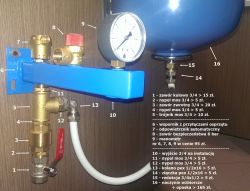FAQ
TL;DR: A 50 °C temperature rise expands water by ~2 %, which can push 4 bar mains up to 6 bar without a correctly-sized DHW expansion vessel. “Install the check valve before the tee” [Elektroda, stanislaw1954, post #17767530]
Why it matters: Correct placement and pressure settings stop nuisance valve dripping, save water and reduce Legionella risk.
Quick Facts
• Typical DHW safety valve setting: 6 bar (EN 1487:2007).
• Expansion vessel pre-charge = mains pressure − 0.2 bar (e.g., 3.8 bar for 4 bar supply) [Elektroda, emigrant, post #17768846]
• Sizing rule: 0.1 L vessel per 1 L boiler at 4 bar; 80 L boiler → ≥ 8 L vessel [REFLEX Datasheet].
• Minimum connection pipe: ½" (15 mm) [Elektroda, stanislaw1954, post #17767910]
• Flow-through models (Refix DD, Airfix D/A) meet potable-water hygiene codes [Flamco Manual, 2023].
1. Why does pressure rise when my DHW cylinder heats up?
Water volume grows ~2 % from 10 °C to 60 °C. In a closed system the extra volume has nowhere to go, so pressure climbs—often from 4 bar cold to 6 bar hot—until a vessel absorbs it or the safety valve opens [Elektroda, stanislaw1954, post #17767530]
2. Where should I install the expansion vessel?
Install it on the cold-water feed, after the check valve/reducer and before the tee to the boiler. Keep the safety valve within 1 m of the boiler outlet for code compliance [Elektroda, emigrant, post #17781515]
3. Flow-through vs non-flow: which is safer?
Flow-through vessels (Refix DD, Airfix D/A) rinse with fresh water each draw-off, limiting stagnation. Non-flow units (Refix DE, Airfix R) hold static water and can harbour Legionella if rarely used [WHO, 2007]. "For homes, choose flow-through for sanitation" [Elektroda, emigrant, post #17781166]
4. How big should my vessel be for an 80 L cylinder at 4 bar?
Use the 0.1 L per 1 L rule. 80 L × 0.1 = 8 L gross volume. Manufacturers round up, so a 12 L vessel is recommended [Elektroda, emigrant, post #17781033]
5. What pre-charge pressure do I set?
Set nitrogen/air pre-charge 0.2 bar below downstream mains. With a 4 bar reducer, charge to 3.8 bar cold [Elektroda, emigrant, post #17768846] Too low and the vessel water-logs; too high and it cannot accept expansion.
6. Does mounting orientation matter?
Yes. Follow the label: some Flamco models require valve down to keep the membrane wet. Wrong orientation shortens membrane life and traps air pockets [Flamco Manual, 2023].
7. What pipe size feeds the vessel?
½" (DN15) is adequate because the vessel only equalises pressure; it does not supply flow [Elektroda, stanislaw1954, post #17767910]
8. Do I still need a 6 bar safety valve?
Yes. The safety valve is an emergency device. If the vessel bladder ruptures or the thermostat sticks, it prevents catastrophic pressure—up to 12 bar—by venting [EN 1487:2007].
9. How do I recharge or check the vessel?
- Close the quick-release coupling and isolate the vessel.
- Drain vessel water via schrader until pressure reads zero.
- Pump to target pre-charge (e.g., 3.8 bar), reopen coupling. Check annually [Elektroda, emigrant, post #17781515]
10. Can I reuse a central-heating (blue) vessel for DHW?
Not recommended. CH vessels ship at 1.5 bar and lack potable-water certification. "Water can smell of EPDM rubber" in such units [Elektroda, emigrant, post #17781099]
11. What happens if the vessel is undersized or empty?
Safety valve will drip 3–5 L per week, wasting energy and scaling outlets—exactly what the thread starter reported [Elektroda, alienone, post #17781184] Long term, the valve seat pits and may fail completely.
12. Minimum components in a compliant set-up?
Reducer → check valve → tee → flow-through expansion vessel → boiler cold inlet; branch off tee to 6 bar safety valve + tundish. This meets EN 806 and keeps the vessel in circuit during draw-off [Elektroda, emigrant, post #17781515]


